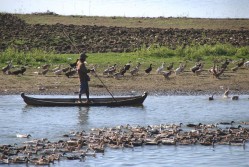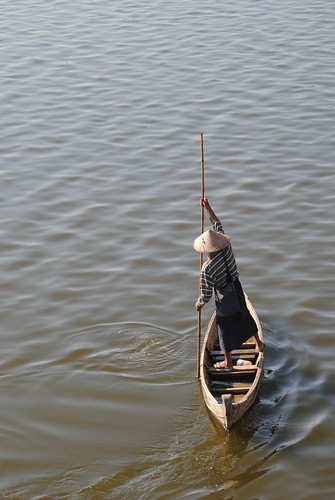Myanmar (or Burma, if you prefer) is one of the most talked-about countries in international media, but definitely one of the least understood. 
Whether I was traipsing the chaotic streets of cities like Madalay and Yangon, strolling through the ancient town of Inwa or tiptoeing my way across the shaky Amarapura Bridge, I found myself immersed in a world I never knew existed. Cast aside any preconceived notions you have of Myanmar and take a trip with me through one of the most interesting places on the planet.

I arrived to Yangon, the Burmese capital, just as night was falling on the town. I knew from the get-go that Myanmar was going to be a rough and tumble place — the taxi I took from the airport to the city center was clearly built in the 1950s, apparently around the time the roads were last paved. What’s cool is that the Burmese don’t let this get in the way of them enjoying themselves. As you can see above, plastic children’s tables are no impediment to enjoy a tasty street café meal at night time.

The interesting thing about Myanmar is that it used to be an extremely wealthy, prosperous place — specifically around 2,500 years ago. Perhaps the most conspicuous illustration of this former glory is Yangon’s Shwedagon Pagoda,pictured above. Allegedly spawned from a gift the country now known as Myanmar achieved from Siddharta, who had just achieved Buddahood at the time, the Shwedagon Pagoda has become slightly more extravagant several times since around 1,400, when monarchs started imposing their own touches onto it.

One upside of Myanmar having little access to the Western world is that you can actually look at advertisements there and not see the tired faces of Lady Gaga or Katy Perry. It was interesting to me to see that although the scope of products and services offered in Myanmar is dramatically less than you would find anywhere in the developed world, some of the same advertising tactics are used — and, as you can see above, with the same attention paid by prospective consumers.

After spending a few days in Yangon I headed north to Mandalay, the largest city in northern Myanmay and its most recent royal capital. Although Mandalay isn’t quite as populous as Yangon, it seems decidedly more chaotic to me. Thankfully, the chaos was often juxtaposed with serenity, as the maroon-robed Burmese monks piled onto these crowded vehicles illustrate beautifully.

It wasn’t until I visited Myanmar that I really began to pay attention to quotidian things and animals, such as pigeons. When I saw this mass of city birds perched on top of a power line just across from Mandalay’s city palace, I couldn’t resist snapping them. In Myanmar, even sights that might be ordinary in the U.S. or Europe seem otherworldly and strange.

Soon, I ‘d find myself heading down the Mandalay river to the old town of Inwa, home to its own famous leaning tower — and to people who live their lives in a practice, functional manner. Although I’m not sure I could ever live without creature comforts like my computer, iPhone or DSLR camera, the way these people lived their lives was a model for sustainability and simplicity from which I think the world could learn.

Another awesome quality of the Burmese people, and in particular the ones I met in and around Inwa, was how friendly and non-judgmental all of them were. I know if I were living a “poor” existence and spent my entire day dealing with “rich” Westerners with their noses point up in the air I would feel bitter after awhile. To me, this seeming lack of disdain is a testament to the character and integrity of people in Myanmar.

In an era of unionized construction crews, automated factories and skyscrapers that rise in a matter of months, I think people in the West have largely forgotten how things are built — and without a doubt, how to build them. Although I do feel sorry that rural people in Myanmar have to work so hard to sustain themselves, their ability to assemble the building blocks of their own lives is awe-inspiring to me.

Robert Schrader is a travel writer and photographer who’s been roaming the world independently since 2005, writing for publications such as “CNNGo” and “Shanghaiist” along the way. His blog, Leave Your Daily Hell, provides a mix of travel advice, destination guides and personal essays covering the more esoteric aspects of life as a traveler.








